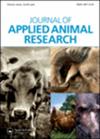A single dose of FSH or hCG during a split-time AI program did not enhance follicular growth or pregnancy per artificial insemination in beef heifers
IF 1.9
4区 农林科学
Q3 AGRICULTURE, DAIRY & ANIMAL SCIENCE
引用次数: 0
Abstract
ABSTRACT The objective of this study was to evaluate the effect of a low dose of hCG or FSH on follicle growth and pregnancy per artificial insemination (AI) in crossbreed beef heifers subjected to a split-time AI program. All heifers (n = 386) were subjected to a 7-d Co-synch protocol and an intravaginal controlled internal drug release (CIDR) device (GnRH and CIDR insertion; 7 days later PGF2α, CIDR removal, and application of a tail head estrus detection patch; 36 hours later AI of heifers detected in estrus, 24 hours later timed AI of remaining heifers). At CIDR removal, heifers were randomly assigned to receive either 150 IU of hCG, 20 mg of FSH, or remained as untreated controls. The diameter of the preovulatory follicle and the pregnancy per AI did not differ among treatments. A smaller (P = 0.035) proportion of heifers in the hCG group were detected in estrus compared with control. Additionally, the incidence of premature ovulation was greater (P < 0.01) among heifers treated with hCG compared with control. In conclusion, using a low dosage of hCG or FSH at the time of device removal did not affect pre-ovulatory follicle growth or the proportion of pregnant heifers.在分段人工智能程序中,单剂量FSH或hCG并不能促进肉牛每次人工授精的卵泡生长或妊娠
本文章由计算机程序翻译,如有差异,请以英文原文为准。
求助全文
约1分钟内获得全文
求助全文
来源期刊

Journal of Applied Animal Research
农林科学-奶制品与动物科学
CiteScore
2.70
自引率
0.00%
发文量
80
审稿时长
6 months
期刊介绍:
Journal of Applied Animal Research (JAAR) is an international open access journal. JAAR publishes articles related to animal production and fundamental aspects of genetics, nutrition, physiology, reproduction, immunology, pathology and animal products. Papers on cows and dairy cattle, small ruminants, horses, pigs and companion animals are very welcome, as well as research involving other farm animals, aquatic and wildlife species. In addition, manuscripts involving research in other species that is directly related to animal production will be considered for publication.
 求助内容:
求助内容: 应助结果提醒方式:
应助结果提醒方式:


